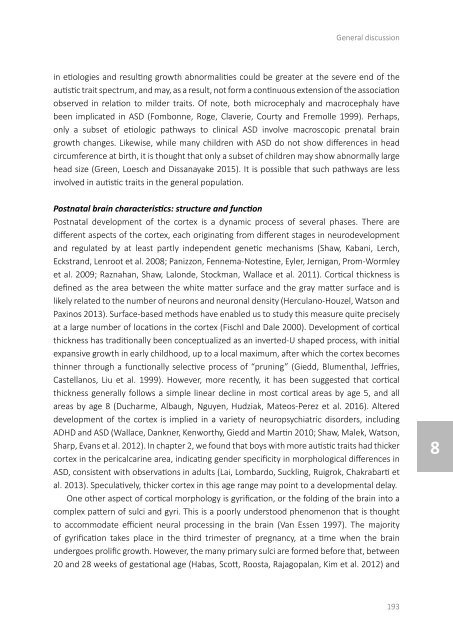On the Spectrum
2lm5UyR
2lm5UyR
You also want an ePaper? Increase the reach of your titles
YUMPU automatically turns print PDFs into web optimized ePapers that Google loves.
General discussion<br />
in etiologies and resulting growth abnormalities could be greater at <strong>the</strong> severe end of <strong>the</strong><br />
autistic trait spectrum, and may, as a result, not form a continuous extension of <strong>the</strong> association<br />
observed in relation to milder traits. Of note, both microcephaly and macrocephaly have<br />
been implicated in ASD (Fombonne, Roge, Claverie, Courty and Fremolle 1999). Perhaps,<br />
only a subset of etiologic pathways to clinical ASD involve macroscopic prenatal brain<br />
growth changes. Likewise, while many children with ASD do not show differences in head<br />
circumference at birth, it is thought that only a subset of children may show abnormally large<br />
head size (Green, Loesch and Dissanayake 2015). It is possible that such pathways are less<br />
involved in autistic traits in <strong>the</strong> general population.<br />
Postnatal brain characteristics: structure and function<br />
Postnatal development of <strong>the</strong> cortex is a dynamic process of several phases. There are<br />
different aspects of <strong>the</strong> cortex, each originating from different stages in neurodevelopment<br />
and regulated by at least partly independent genetic mechanisms (Shaw, Kabani, Lerch,<br />
Eckstrand, Lenroot et al. 2008; Panizzon, Fennema-Notestine, Eyler, Jernigan, Prom-Wormley<br />
et al. 2009; Raznahan, Shaw, Lalonde, Stockman, Wallace et al. 2011). Cortical thickness is<br />
defined as <strong>the</strong> area between <strong>the</strong> white matter surface and <strong>the</strong> gray matter surface and is<br />
likely related to <strong>the</strong> number of neurons and neuronal density (Herculano-Houzel, Watson and<br />
Paxinos 2013). Surface-based methods have enabled us to study this measure quite precisely<br />
at a large number of locations in <strong>the</strong> cortex (Fischl and Dale 2000). Development of cortical<br />
thickness has traditionally been conceptualized as an inverted-U shaped process, with initial<br />
expansive growth in early childhood, up to a local maximum, after which <strong>the</strong> cortex becomes<br />
thinner through a functionally selective process of “pruning” (Giedd, Blumenthal, Jeffries,<br />
Castellanos, Liu et al. 1999). However, more recently, it has been suggested that cortical<br />
thickness generally follows a simple linear decline in most cortical areas by age 5, and all<br />
areas by age 8 (Ducharme, Albaugh, Nguyen, Hudziak, Mateos-Perez et al. 2016). Altered<br />
development of <strong>the</strong> cortex is implied in a variety of neuropsychiatric disorders, including<br />
ADHD and ASD (Wallace, Dankner, Kenworthy, Giedd and Martin 2010; Shaw, Malek, Watson,<br />
Sharp, Evans et al. 2012). In chapter 2, we found that boys with more autistic traits had thicker<br />
cortex in <strong>the</strong> pericalcarine area, indicating gender specificity in morphological differences in<br />
ASD, consistent with observations in adults (Lai, Lombardo, Suckling, Ruigrok, Chakrabarti et<br />
al. 2013). Speculatively, thicker cortex in this age range may point to a developmental delay.<br />
<strong>On</strong>e o<strong>the</strong>r aspect of cortical morphology is gyrification, or <strong>the</strong> folding of <strong>the</strong> brain into a<br />
complex pattern of sulci and gyri. This is a poorly understood phenomenon that is thought<br />
to accommodate efficient neural processing in <strong>the</strong> brain (Van Essen 1997). The majority<br />
of gyrification takes place in <strong>the</strong> third trimester of pregnancy, at a time when <strong>the</strong> brain<br />
undergoes prolific growth. However, <strong>the</strong> many primary sulci are formed before that, between<br />
20 and 28 weeks of gestational age (Habas, Scott, Roosta, Rajagopalan, Kim et al. 2012) and<br />
8<br />
193


